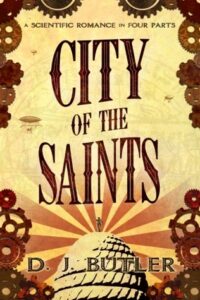Review of City of the Saints by D. J. Butler
 City of the Saints by D. J. Butler (WordFire Press, 2015) is a alternate history steampunk tale of a technologically advanced United States on the eve of the Civil War. With characters including Samuel Clemens, Edgar Allan Poe, Richard Burton, and Brigham Young (and many of his Mormon associates), it’s a wild, multi-point of view ride.
City of the Saints by D. J. Butler (WordFire Press, 2015) is a alternate history steampunk tale of a technologically advanced United States on the eve of the Civil War. With characters including Samuel Clemens, Edgar Allan Poe, Richard Burton, and Brigham Young (and many of his Mormon associates), it’s a wild, multi-point of view ride.
In this alternate history, the Kingdom of Deseret has airships and a devastating weapon that promises the government who has it the capacity to claim battlefield superiority. As the Northern and Southern states race toward a likely war, both sides have dispatched representatives to go to Deseret and offer the Mormons various prizes in exchange for sharing their technology with said representatives’ side. The British have also gotten involved, because war in America will impact them as well. But there are also hidden personal agendas and past events that complicate the travel and negotiations. When the circumstances shift, things go sideways, forcing the participants to look to new, unplanned alliances.
It can be tricky to use historical figures as the main characters in a novel, but Butler manages these personalities well. Probably the more difficult part for the reader is that the multiple points of view can be a bit dizzying. The three main representatives (Clemens, Poe, and Burton) each have an assistant, and these six characters each have their own point of view sections. But overall, that works to tell the entire story, as there’s not much overlap between what each character is doing, even when they are in the same general location. My bigger complaint is that none of the female characters get a point of view section, and I’d love to get to read some parts of this story from their perspective.
If you’re a fan of alternate history steampunk tales like Wild, Wild West, the Deadlands roleplaying game, or books by Gail Carriger, you may enjoy this take on mid-nineteenth century America and some of its more colorful personalities.

Comments